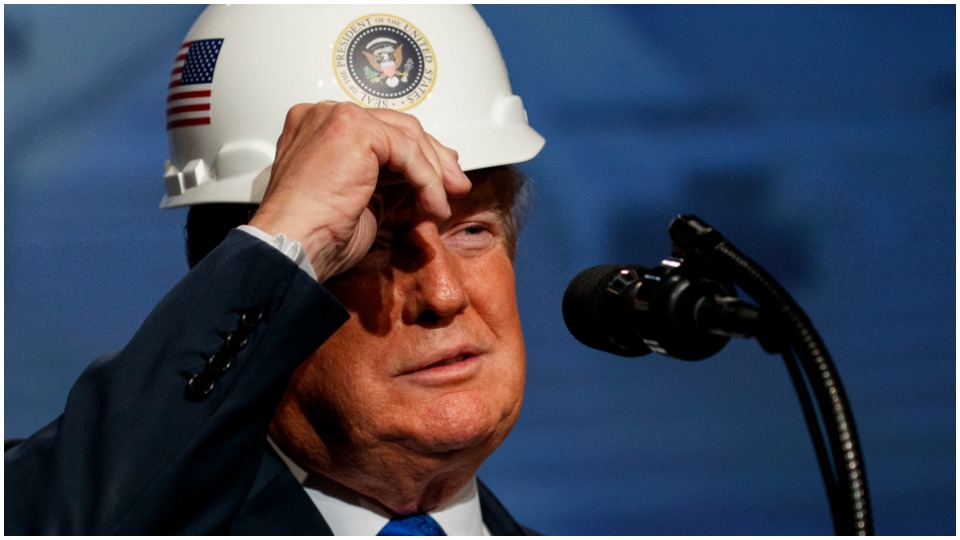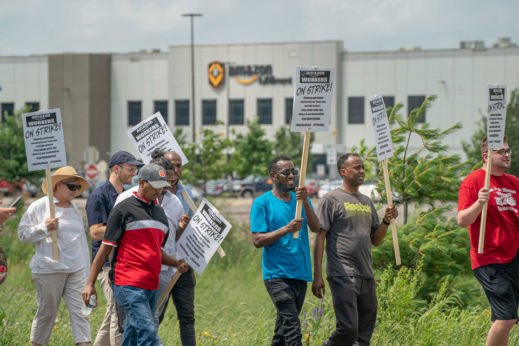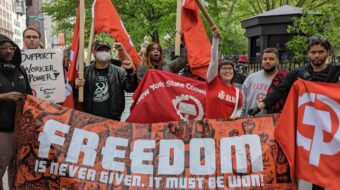
This article won an Honorable Mention award in the Best Editorial or Column category at the 2020 Labor Media Awards, presented by the International Labor Communications Association.
The U.S. working class has received special attention from the Trump campaign’s first days; since his election, it has been singled out for special assault.
“America First” was portrayed as making working-class America first; “Make America Great Again” meant reawakening the greatness of the American working class.
But the Trump agenda as thus marketed had a not-so-subtle double edge: “America First” meant putting “forgotten” white workers first. American greatness meant a back-to-the-future return to a Happy Days-inspired Wonder Bread-like suburban past, where blacks knew their place, Mexican Americans (always a visible, vibrant part of the American fabric) were rarely seen, and Asians didn’t exist.
Clearly, Trump’s assault was primarily aimed at workers of color: immigrants, African Americans, Muslims. But it’s vital to point out that this offensive is directed at the working class as a whole. It’s not only Central American migrants fleeing poverty and violence who are demonized and pitted against U.S. citizen workers; workers in private industry are played off against government employees; people who have jobs are portrayed as having interests apart from the unemployed; rural workers are depicted as having a culture vastly different from those in the cities—even workers in basic industries are posed against one another.

The attack has been many-sided: political, psychological, and ideological. It has been legal and extra-legal. Trump has used threats, intimidation, racism, national chauvinism, and sexism in a no-holds-barred attempt to maintain his base and utilize the machinery of state power to “win ugly,” but at all costs win.
The anti-worker president
While the conquest of political power is doubtless a goal, for the forces gathering around the Trump administration winning is a thing beyond victory in elections. The real aim here is the complete subjugation of the working class in its entirety to create the best conditions for reducing labor costs and maximizing profits. And to achieve this they must break the back of the trade unions, who present their chief and most consistent obstacle—it’s class struggle in the raw.
Notwithstanding attempts to portray himself as a “proletarian billionaire,” Trump is the most anti-worker president in recent history.
His administration wasted no time in implementing anti-worker measures. In its early days, they opposed raising the federal minimum wage and supported the GOP repeal of Obama’s Fair Play and Safe Workplace executive order protecting workers from wage theft.
Trump also delayed implementation of the fiduciary rule requiring Wall Street investment “advisors” to act in the best interests of their working-class clients, costing workers tens of millions of dollars. Much to the GOP’s and Wall Street’s pleasure, the rule was later made null and void by the Fifth Circuit Court of Appeals.
Setting his sights on federal workers, early on Trump canceled a proposed 2% wage increase. The administration then initiated a series of anti-labor actions. At the top of the list was an Obama-era regulation governing overtime. Workers now had to earn over $35,000 a year instead of $23,000 before the requirement for overtime pay kicked in.
Trump was just getting started. According to the Washington Post, he went on to set aside regulations making large contractors reveal labor law violations and removed a rule making corporations keep records of worker injuries from year-to-year.
Attack on women and LGBTQ rights
Rules assisting working-class women were also set aside. Trump rescinded the “2014 Fair Pay and Safe Workplaces order President Barack Obama had put in place to ensure that companies with federal contracts comply with 14 labor and civil rights laws.”
The rule covered two issues affecting women workers: paycheck transparency and forced arbitration clauses for sexual harassment, sexual assault, or discrimination claims.
The paycheck transparency rule addressed the problem that out of the 50 worst wage-theft violators that the Government Accountability Office examined between 2005-2009, 60% had been awarded federal contracts even after being penalized by the Department of Labor’s Wage and Hour Division. The rule barred the granting of federal contracts to companies involved in wage theft.
Another proposed rule change would remove Obamacare’s anti-discrimination measures designed to protect transgender care. The proposed changes would eliminate protections from discrimination on the basis of gender identity and sex stereotyping.
If the rule goes into effect, health care providers could refuse to cover transition-related health care costs for transgender patients.
A conscientious objection rule change finalized in June impacts both transgender patients and those seeking abortions. It exempts those with moral objections from a penalty for refusing medical care that they claim violates their religion.
Deregulation

Trump’s objective with these measures? Create a “good business atmosphere,” that is, a climate good for corporate profits. The means to achieve it? Deregulation—the removal of regulations governing capital’s relations with labor and society in general, including the environment, health and safety, collective bargaining, reproductive rights, wage theft, overtime, child labor, voting rights, you name it.
Enacting the Chamber of Commerce and Wall Street agenda, Trump demanded “two for one,” that is, two regulations be eliminated for every one enacted, measures that affect workers’ rights in every conceivable way.
Deregulation of rules on health and safety, for example, resulted in jettisoning guidelines protecting workers from hazardous chemicals. In order to save industry some $11 million a year, the Trump administration canceled a requirement for training for construction and shipyard workers to avoid exposure to beryllium, a known carcinogen.
Another set of rule relaxations were aimed at worker compensation. Corporations would no longer be required to keep multi-year records of workplace injuries. Adding insult to injury, in a case before the Supreme Court, the Trump administration attempted to persuade the justices to end collective action suits regarding injuries.
The Department of Labor is now the chief promoter of big business
The main vehicle for implementing Trump’s anti-worker agenda has been the Department of Labor. Under Trump, the DOL has turned into its opposite. It has become the chief promoter of big business, and it’s done so with a vengeance. Over and over again, it’s taken measures to weaken organized labor. The DOL has:
— proposed repealing a rule that employers report how much they’ve spent on anti-union campaigns;
— reversed a rule supporting worker rights to organize free of employer interference;
— terminated a decision on unions’ right to bargain on terms of employment;
— suggested companies end agreements to hold union elections.
Of enormous consequence with respect to organizing fast-food workers—many of whom are African-American and Latino—at McDonald’s and other similar establishments, the DOL overturned a “decision making employers responsible for bargaining with workers if they have direct or indirect control over these worker’s employment.” They did so by narrowing the joint-employer standard “to the point at which many workers would find it nearly impossible to bring all firms with the power to influence their wages and working conditions to the bargaining table.”
These fast-food restaurants had gotten around organizing by making each individual company a franchise allegedly independent of the parent corporation.
The DOL’s anti-union actions didn’t end there. They issued executive orders limiting the amount of time workers can do union business and demanded federal agencies arrange union contracts in less than a year. They also rescinded the Obama-era “persuader” rule, which required employers to disclose their relationships with union-busting law firms.
Even laws preventing child labor are under threat of being reversed
New rules would allow teenagers to be employed as operators of power-driven patient lifts in hospitals and nursing homes.
By all expectations, Trump’s new head of the DOL will make matters far worse. The union-busting son of the late Justice Antonin Scalia is a well-known defender of corporate interests. Eugene Scalia took on Walmart as a client in opposing health care spending for employees. The U.S. Chamber of Commerce hired him to oppose the fiduciary rule.
Scalia is likely to approve yet another new rule the DOL has forwarded to the White House. It would require extensive financial reporting by state public worker unions, tying unions up in red tape while they’re preparing for upcoming state legislature battles.

Trump’s announced change in the public charge rule (public charge means anyone receiving government benefits) would deny green cards to working-class legal immigrants. The rule favors wealthy immigrants from wealthy countries over workers who come here without pre-existing resources. Some 365,000 immigrant workers would be directly affected, but the repercussions could extend to millions.
Trump’s target: Working-class unity
Thus, in nearly every arena—be it immigration, protections for women workers, LGBTQ rights, collective bargaining, health and safety, or the environment—Trump has systematically undermined and removed benefits and protections won by our country’s working class over decades. Trump’s policy is implementing the wishlist of each corporation with them in charge. Most notable here is the energy sector and the rollback of environmental along with health and safety standards.
More broadly, Trump aims at breaking the unity between the multi-racial working class and its democratic allies.
As a result, the wages, health, and living standards for all workers are being lowered, particularly for workers of color and women. All working people and poor, in fact, all of good faith living in the U.S., have a big stake in combating this anti-working class agenda by removing Trump and his GOP supporters from office. It is the chief political imperative of our times.












Comments